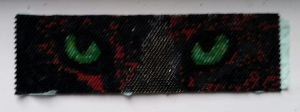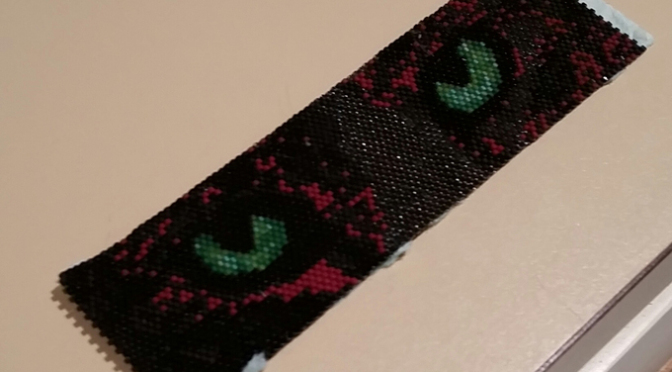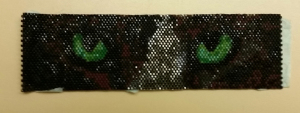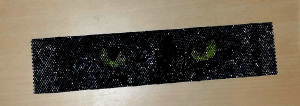Black animals are hard to photograph — they look like blobs of black in most light — and they’re just as hard to bead. Harder, in some ways, because a camera will record whatever color it sees. Not necessarily the color that the human eye sees, and not necessarily a color for which there is a matching Delica.
I made several peyote weave pictures for Squib’s scrapbook (having not yet gotten into my loom groove). Most of the patterns featured black cats, but the most realistic “cat eyes” pattern I could find had a tabby with a white streak down the nose:
Hannah Rosner’s Cat Eyes Cuff Pattern
For my first take on the pattern, I lumped half of the original colors into a new “black” category (using Delica DB10, opaque black) and the others into the “brown” category, using DB1584 (opaque matte espresso bean).
(This approach failed, a lot. Even if the DB1584s had not been playing some evil beady Jekyll-Hyde game, the final bracelet looked blotchy rather than naturally striped. My second pass was more successful; see below.)
Delicas are the bead of choice for most weavers I know, because they are very consistent in color and size. Well, mostly consistent. A couple, maybe more, shades of Delica browns change color dramatically, depending on the light.
The following are not great photographs (I’m less than inspired to take great pictures of a collection of bad artistic decisions), but they show the effect of light on DB1584.
I work under a daylight lamp, which is fluorescent, and this is probably why I didn’t know I had a problem until it was much too late.
This picture shows the bracelet under fluorescent light. It looks okay; there’s still more red in the image than is visible to the naked eye, but it’s still “brown.”
Here’s what happens when you look at the bracelet under daylight, through a window:
 Aside from being ugly all on its own, the red shows how badly my “black or brown” choice to replace colors worked out. Ugh.
Aside from being ugly all on its own, the red shows how badly my “black or brown” choice to replace colors worked out. Ugh.
And this is what the bracelet looks like under the incandescent lights in the bathroom (the angle is weird because the lights are not usefully placed to photograph objects on the counter):  Yeah, it’s really bright. Really bright RED. Wow.
Yeah, it’s really bright. Really bright RED. Wow.
I don’t have a comprehensive list of the Delicas that display this change, but I’m starting to keep one. The only other problematic color I know about it DB1134 (opaque chocolate); one of my vendors shows the shift in their image of the bead.
Delica DB1134 Opaque Chocolate
There’s no fix except to avoid those colors. I am buying brown Delicas locally so I can be sure they don’t pull this nasty little stunt.
If you’ve had a similar experience with other Delica colors, or have other info on the topic, please leave a comment. I’ve poked around at Miyuki’s site but haven’t seen anything.
And for those who are interested, here’s the cuff woven with my second set of colors.
I used Hannah’s pattern because it was the most natural looking of the ones I could find.
Second time around, I assigned a different shade of dark grey to each of the original colors in Hannah’s pattern, with no brown at all. There aren’t many options for shades of black and grey in the Delica line — I tried to avoid anything with an AB or luster coating, but had to use several metallic shades to have enough colors at all.
My final’s not natural looking at all (unless you’ve galvanized your cat). But it is more realistically detailed and more interesting to look at than my first try.



This is a great blog post! I’m sorry that the translation to the black kitten was such a pain, but your comments about working the colors were fascinating and also I enjoyed every bit of the writing. Can I share the photo of the “galvanized cat” on my Facebook page?
I would be delighted! Thanks for your kind comments. I am certainly learning a lot about how to imitate the color black using other dark colors…